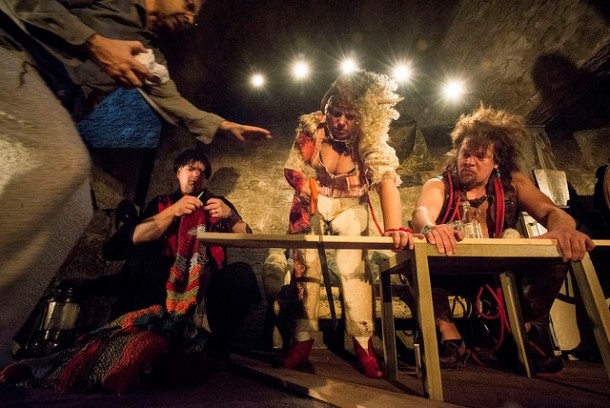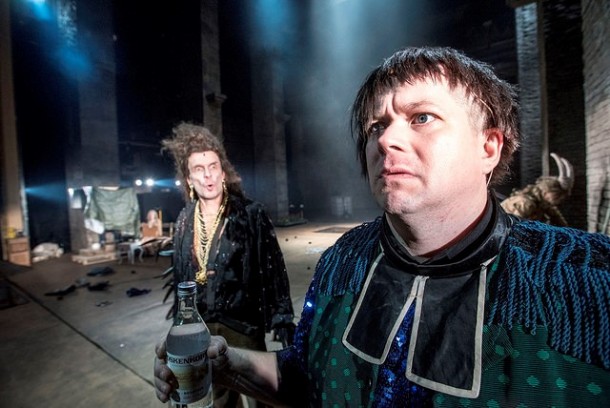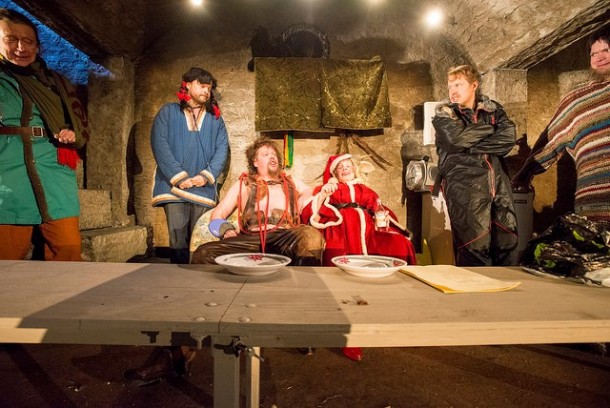Actress, director, and playwright Leea Klemola and her brother Klaus Klemola are known for their original plays colored with a peculiar sense of humor, bizarre characters, and unexpected relations between them. Their professional co-operation started with a play called Kokkola (2004) and its two sequels Into the Cold (2008) and New Karleby (2011). Leea wrote and directed the first two, while Klaus played one of the leading roles; the third play they wrote together. These three plays form the so-called Arctic Trilogy, and they have all been translated into English.
The most striking feature of the Arctic Trilogy is the subversion of conventional gender roles: harsh, obtrusive, and aggressive female characters dominate caring and gentle male ones. Also, the Trilogy gradually introduces animal characters, sequel by sequel increasing their significance. In Kokkola, a seal appeared briefly as a result of a temporary metamorphosis of the main female character—or, if you like, as a result of her scheme; Into the Cold featured three Greenland dogs and five musk oxen, and New Karleby featured a group of spotted hyenas. This anticipated what their most recent work was to offer.
Maaseudun tulevaisuus (The Future of Our Countryside) by Leea and Klaus Klemola opened on the Main Stage of the Finnish National Theatre in November 2014. It was the debut of the Klemolas at the National Theatre and in the capital in general; the Arctic Trilogy was produced and performed in Tampere.
Before writing their newest play, Leea and Klaus Klemola (together with their dramaturge Rosa-Maria Perä and film director Juho Kuosmanen) visited Mongolia. Travelling has become a crucial part of their methodology; when outlining a new play they travel to places that are linked to their topics (the Arctic Trilogy took them to Greenland and Africa). Their observations of Mongolian nomadic life that is based on the interdependence and unquestioned coexistence of humans and animals, including its shamanistic practices, eventually influenced elements of the play’s plot.

Miko Kivinen, Klaus Klemola, Sari Puumalainen and Ville Haapasalo in The Future of Our Countryside by Leea and Klaus Klemola at the Finnish National Theatre. Photo credit: Tuomo Manninen
Nevertheless, it is obvious that the humans, their pets and farm animals, are inhabitants of contemporary Finnish—not Mongolian—society. The animals are a curious mixture of human and animal features; although they speak fluently and are acknowledged members of society, they also have some qualities clearly typical for their species: the dogs urinate in order to signal their presence, the horses show fear for unknown and unexpected reasons, and the sheep flock. The opening of The Future of Our Countryside was surrounded by a media sensation. Heavy cursing, nudity, and, on top of all, bestiality and infanticide were too much for some spectators and made them leave the auditorium ostentatiously which, of course, was eagerly reported by the press. Internet discussion followed. However, the stir soon blew over. The reviews were positive. A columnist of a Finnish periodical of performing arts, author and dramaturge Laura Gustafsson wrote that the real sensation in Leea Klemola’s debut at the National Theatre was that it did not take place earlier.
Personally, I think the causes of the sensation were like a security blanket covering the real problems the performance highlighted and some spectators and commentators preferred to notice only the violent language instead of grappling with the burning issues inflicting Finnish society. The image the production presents, while totally unlike contemporary Finland, presents a future that is frightfully recognizable and one already embedded in the current political moves and discussions. This really would have been worth some uproar in the media but, unfortunately, I have not seen much public commentary inspired by the political aspects of the play.
While The Future of Our Countryside, as the title suggests, is a vision of the future, it is far from futuristic. When the curtain opens, we see a huge empty space that proves to be an old church, perhaps a cathedral. At the rear end of the stage we see a modern tractor half sunken in the floor of the church. (The stage designer Erkki Saarainen and costume designer Tuomas Lampinen received the Illusion Prize awarded by the Trade Union for Theatre and Media for the designs for this production and for the Arctic Trilogy). The image describes the essential situation in the play: the tractor indeed got stuck in the church floor when the main character of the play, a former drummer played by Klaus Klemola, tried to farm inside the church, currently his home. The tractor turns out to be the most modern device we see on the stage implying that technology does not serve humankind particularly well. And indeed, the play’s action shows how old, seemingly backward solutions triumph; the tractor remains stuck, the refrigerator remains empty, but the spinning wheel and knitting needles are diligently in use.
In The Future of Our Countryside, many of the iconic signs—the church space, a priest’s collar worn by the drummer at times, shamanistic practices that he performs—point to religious or spiritual themes. However, neither religion nor spirituality is at the core of the play. Religion, either Christianity or shamanism, appears not to be important as a system of beliefs; if anything, it provides a system of symbols to be used as a medium of exchange in the curious economy of the play. Instead of the iconic signs, The Future of Our Countryside invites the spectator to interpret indexical signs, thus pointing to something that has left its traces all over the world of the play but whose presence has turned into absence. This invitation is presented in the form of a teasing anomaly: the world created on the stage resembles Finland in the 21st century, yet somehow it is fundamentally out of place. The combination of the realistic and absurd elements tease and provoke questions about the nature of the represented reality and its inhabitants’ skills and abilities to live in that reality. We also notice that it is the reality itself, or something in the reality, that confuses the people and makes them act in chaotic, odd ways.
Most remarkably, the miniature society of the play seems to have no operative power relations. It represents a gathering of the powerless, where even those who are in a dominant position refuse to exert their power over the others. Also, the characters, human and animal alike, have a driving need for community, communion, communication of some kind, but they also seem to be incapable of developing any social bond. All they manage to do is to create loose alliances, which at some point break, causing disappointments.

Jukka Puotila and Klaus Klemola in The Future of Our Countryside by Leea and Klaus Klemola at the Finnish National Theatre. Photo credit: Tuomo Manninen
The characters’ lack of skills (or their refusal to use them) is reminiscent of the caricatures of welfare states that depicts their residents as feeble good-for-nothings. The depiction the play offers, however, is far from mocking or accusatory, but rather gentle, accepting, and empathic towards the spiritual emptiness, physical lapses, and social breakdowns of the characters. Their persistent problems and their hyperbolic attempts to solve them produce absurd and grotesque comedy, but their attitudes prevent the play from turning into tragedy even when the situation approaches a catastrophe.
The Finland of The Future of Our Countryside is divided into two provinces. The story takes place in the northern one where all organizing power is absent. The only thing left are the restrictions, most importantly the prohibition to slaughter animals. Whether this is good or bad is left undetermined, but since more than half of the characters in the play are animals, the animal right’s viewpoint is obviously relevant, therefore the prohibition to slaughter animals may be considered as positive. However, since the humans do not seem to be capable of taking care of their own nutrition, let alone that of the animals in their care, the survival of this province is questionable.
The group that gathers in the church grows little by little. The drummer, his dog, and his ewe arrive first. The drummer used to play in a band on a cruise ship sailing between Finland and Sweden, but he now raises lambs, caring for a flock of one single half-burned sheep. Because the sheep is a gregarious animal, the dog is designated to keep her company. However, this does not seem to help the ewe (played by Sari Puumalainen) in her situation; she is cynical, inclined to alcohol and drugs, even suicidal. As for the dog (played by Miko Kivinen), he misses the good old times on the cruise ship, when he and his master, just the two of them, had time to spend together. He especially misses eating at the buffet..
Soon, more characters join in. A woman (Pirjo Määttä) who has trouble using her hands and feet arrives asking to participate in the handicraft club being formed. She is not actually welcomed by the drummer because he wants to keep the club for men and animals only, but she insists on staying. After her, an artist (Olli Ikonen) arrives with his co-worker, a horse. The artist’s ambition is to create a gigantic felt horse’s eye so big that it can be seen from the moon. The horse (Ville Haapasalo) is very violent and frequently beats up the artist in spite of the artist’s endless kindness.
After the handicraft club has settled down to their activities, a new group arrives. First comes a farmer (Heikki Pitkänen) from the neighbouring farm with his dog (Karin Pacius), soon followed by his goat (Mari Turunen) that is the shop steward of the farm and the farmer’s lover. She is pregnant. Also, three teenage horses (Isla Mustanoja, Anna Miettinen, Reetta Karhu) arrive with this group. The other animals from the neighbouring farm are on strike and have started a revolt, which insults the farmer so much that he gives up his farm, hands over his keys to the rooster who leads the strike (Juha Varis), and renounces all things associated with animals, including all his leather goods and woolen clothes. He even goes so far as to change his name because it resembles the word for pig’s ear too closely.
At this point, the play makes intertextual references to international and Finnish classics. The Orwellian revolution of the animals can also be seen as a variant of the beginning of the Finnish Civil War of 1917-18 that was depicted, for instance, by Väinö Linna in his trilogy Under the North Star, and the films based on it. Furthermore, the morganatic liaison between the farmer and his goat refers to a well-known play from the 1940’s by Hella Wuolijoki about the liaison between a master and a maid. Naming the goat after the maid in Wuolijoki’s play makes this association explicit.
The last arrival is a horse, more precisely, the spirit of a dead horse (played by Jukka Puotila) who is the drummer’s guide in the world of spirits. They connected at a weekend course on spiritual life that the drummer took before he left his job on the ship and moved into the church. During the course, the drummer learned the technique of traveling with the aid of a shamanistic drumming, and established the connection to his power animal—the dead horse—whose advice he followed until the horse disappeared, leaving the drummer at a loss. From the beginning of the play, the drummer desperately seeks his power animal, yet, in spite of all his attempts, the horse—or the fairy, as the drummer chooses to call him—remains silent and invisible.
The world and the problems depicted in the play begin to connect to current discussions about the future of the welfare state in Finland focusing on whether it can be sustained, what its services will include and for whom, and what will be its territorial coverage beginning with the division into two provinces, indicating the division into the haves and the have-nots.
The services of the welfare state that citizens most often encounter in their everyday life are education, health care, and infrastructure, and these surface in The Future of Our Countryside. Education is represented by the drummer’s weekend course in spiritual life and an Icelandic correspondence course on “Leader Sheep” training that the goat has graduated from. These examples gently satirize the commercial education market: the trendy new age type of courses, and the equally trendy “management training.” But it is gentle satire, because I think the playwrights take quite seriously the problems that lead to these kinds of trends, if not their solutions.
Those in need of health care, the woman with dysfunctional limbs and the artist, who is badly beaten by his horse, persuade the drummer to take care of them. They believe that his shamanistic skills and communication with the power animal give him the capacity to offer the health care services for the community. The drummer hesitates at first, but finally concedes, especially when he finds out that the health care center is on sale for a very low price. So he enters into the healing business in collaboration with his fairy, the dead horse.
Like education and health care, the state of the infrastructure in the northern province disintegrates almost completely; since the road to the southern province has collapsed, the small community in the church is eventually threatened with starvation. Because the Road Office has been outsourced to China, it looks like repairing the road is not a priority, and one of the characters assumes that the road will be repaired in China. The northern province is left on its own.
The location, a church falling into ruins, speaks of the decline of religion in the community, while the drummer’s immersion in neo-shamanistic activities points to an individual search for spiritual needs. However, this spiritualism assumes a therapeutic function when the shamanistic practices are used for healing and soon develop into a successful business. Another type of conflation also takes place between religion and entertainment, particularly in respect to explaining death. The ferry that takes the dead over to the hereafter has the shape of the cruise ship between Finland and Sweden—and is even operated by one of the shipping companies known for that route.

Olli Ikonen, Juha Varis, Ville Haapasalo, Sari Puumalainen, Heikki Pitkänen and Klaus Klemola in The Future of Our Countryside by Leea and Klaus Klemola at the Finnish National Theatre. Photo credit: Tuomo Manninen
The Klemolas have defined their work as a pastoral play. Nevertheless, the Nature in The Future of Our Countryside resembles more closely the strange and unpredictable Nature in Shakespeare’s A Midsummer Night’s Dream than a pastoral idyll. Moreover, some reversed images also produce references to this classic. Whereas Shakespeare has a group of craftsmen playing theatre, the Klemolas make the theatre a scene of the handicraft; knitting is the most important thing for many of the characters, first of all for the drummer. Keeping the stitches in order means keeping the world in order. Whereas the characters in A Midsummer Night’s Dream frolic in the wilderness of the deceptive, erratic forest, the characters from The Future of Our Countryside seek safety and pack into the church, often even into the tiny crypt in the cellar. And whereas Shakespeare’s characters whirl in their moment of becoming feral, Klemolas’ characters are stuck in their tameness. Last but not least, The Future of Our Countryside is kin to Shakespeare’s work through its dramatic structure: there is no concentrated plot, but a web of several meandering plots that tangle together and become concluded one by one somewhere along the tapestry.
is a doctoral student in the Department of Philosophy, History, Culture and Art Studies /Theatre Research at the University of Helsinki. She has worked at the Universities of Helsinki and Tampere since 2002 lecturing on theatre criticism, performance analysis, and theatre history. She has participated in several publications writing especially about Finnish theatre since the 1990’s, theatre criticism theory and actors’ work. Her reviews have been published in several Finnish newspapers and periodicals.
European Stages, vol. 4, no. 1 (Spring 2015)
Editorial Board:
Marvin Carlson, Senior Editor, Founder
Krystyna Illakowicz, Co-Editor
Dominika Laster, Co-Editor
Editorial Staff:
Elizabeth Hickman, Managing Editor
Bhargav Rani, Editorial Assistant
Advisory Board:
Joshua Abrams
Christopher Balme
Maria Delgado
Allen Kuharsky
Jennifer Parker-Starbuck
Magda Romańska
Laurence Senelick
Daniele Vianello
Phyllis Zatlin
Table of Contents:
- Report from Berlin by Yvonne Shafer
- Performing Protest/Protesting Performance: Golgota Picnic in Warsaw by Chris Rzonca
- A Mad World My Masters at the Barbican by Marvin Carlson
- Grief, Family, Politics, but no Passion: Ivo van Hove’s Antigone by Erik Abbott
- Not Not I: Undoing Representation with Dead Centre’s Lippy by Daniel Sack
- In the Name of Our Peasants: History and Identity in Ukrainian and Polish Contemporary Theatre by Oksana Dudko
- Performances at a Symposium: “Theatre as a Laboratory for Community Interaction” at Odin Teatret, Holstebro, Denmark, May, 2014 by Seth Baumrin
- Songs of Lear by the Polish Song of the Goat Theatre by Lauren Dubowski
- Silence, Shakespeare and the Art of Taking Sides, Report from Barcelona by Maria M. Delgado
- Little Theatres and Small Casts: Madrid Stage in October 2014 by Phyllis Zatlin
- Gobrowicz’s and Ronconi’s Pornography without Scandal by Daniele Vianello
- Majster a Margaréta in Teatro Tatro, Slovakia by Miroslav Ballay
- Remnants of the Welfare State: A Community of Humans and Other Animals on the Main Stage of the Finnish National Theatre by Outi Lahtinen
- Mnouchkine’s Macbeth at the Cartoucherie by Marvin Carlson
- Awantura Warszawska and History in the Making: Michał Zadara’s Docudrama, Warsaw Uprising Museum, August, 2011 by Krystyna Illakowicz and Chris Rzonca
Martin E. Segal Theatre Center:
Frank Hentschker, Executive Director
Marvin Carlson, Director of Publications
Rebecca Sheahan, Managing Director
©2015 by Martin E. Segal Theatre Center
The Graduate Center CUNY Graduate Center
365 Fifth Avenue
New York NY 10016



